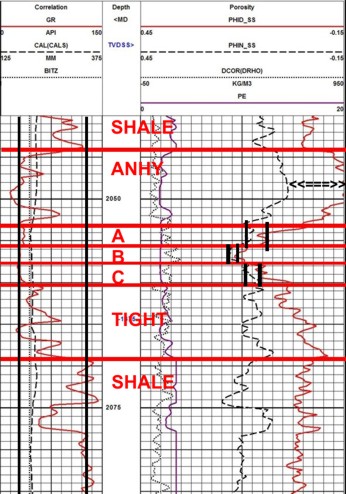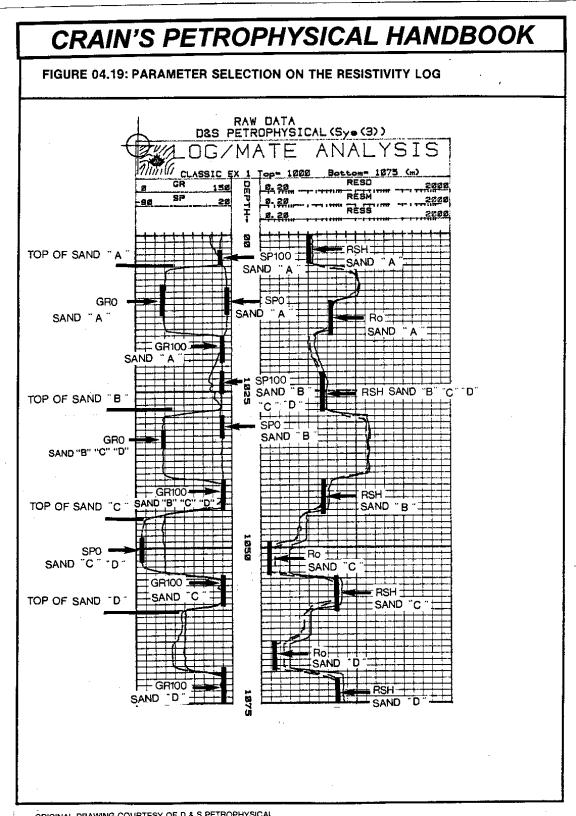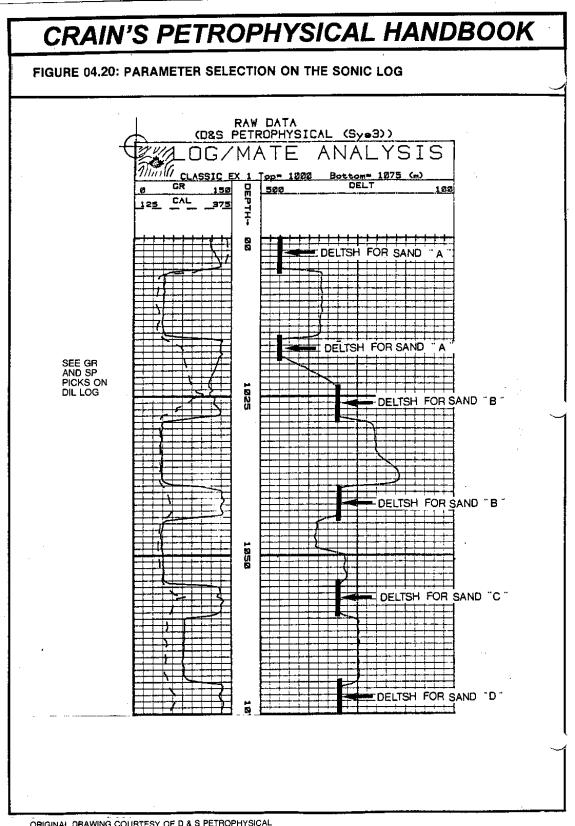|
 "BOX THE LOG" TO READ OR PICK LOGS
"BOX THE LOG" TO READ OR PICK LOGS
In order to perform a log analysis, it is necessary to read or
pick log values in the various zones of interest, and other key
locations, such as in shale or water bearing zones. Picking
log values and analysis parameters from logs is THE most important
step in quantitative log analysis. Mathematics cannot compensate
for poor selections. Few comments on this subject are found in
service company training manuals. As a result, beginners often
find it difficult to start with valid data, or assume the task
is easy and requires no thought or knowledge.
Selections
should be made on a consistent basis from day to day to assist
reproducibility of results. When using digital log data, the digits
themselves will be used by the computer program, but the analyst
must still pick numerous values by observation of log curves,
crossplots, or data listings.
In
computer aided log analysis, picks are made continuously with
a digitizer or by reading magnetic tapes or discs created when
the logs were recorded. Such data tends to be more accurate than
hand picked values. Accuracy can be a hindrance on noisy logs,
rounded bed boundaries, or in large or rough holes. Some editing
or curve shaping may be required prior to digitizing, hand picking
data, or using existing digitally recorded data.
To
select a log value, it is helpful, especially for the novice, to
"box the log". Draw horizontal lines at each bed boundary,
at the inflection points on each curve. Draw vertical lines on
each curve at the peaks and valleys, thus transforming the log
into a series of individual beds with a single specific log reading.
For thicker reservoir layers, an average value may be chosen if
the log curve does not wiggle too much.
 
Reading well logs is made easier
by "boxing the log". Horizontal lines (bed boundaries) and vertical
lines
(log values or log readings) form boxes that bound the data to allow
valid data picks. Be sure to honour the "peaks and valleys" rule in
thin beds.
With
experience, it is possible to simply mark points at the peaks
and valleys without drawing horizontal lines, as shown in the
lower part of the example. Unless
absolutely necessary, values should not be selected on slopes.
Slopes indicate transition from one condition, such as porosity
or hydrocarbon content, to another. Average values, halfway along
the slope may be meaningful, but can also be misleading. Do not
select values in thin beds unless you are also prepared to make
bed thickness corrections.
Be
sure to pick the correct curve, its appropriate scale, and edit
any noise or bad hole conditions prior to finalizing values.
Write the log values picked into a table or
preprinted form so that you will have a record of the data you
are using. Note that very shaly zones are not usually
interpreted. Therefore, this data can be left off the table or
marked as shale with no data values entered.
SHALY SAND EXAMPLE –
Depths in Feet
(Logs above were in meters)
RAW DATA PICKS
Shale Properties:
Gamma Ray clean line (GR0) ___22___ api units
Gamma Ray shale
line (GR100) ___105___ api units
SP clean line
(SP0) ____14___ mv
SP shale line
(SP100) ____78___ mv
Density shale
line (PHIDSH) __0.03___
Neutron shale
line (PHINSH) __0.26___
Sonic shale line
(DTCSH) ___NA___ us/m
Resistivity shale
line (RSH) ___20____ ohm-m
Resistivity of Water Zone (R0) ___2.7___ ohm-m
Log Data Values for
Layers
A: Sh Sd B: Oil C: Water
Layer
Top
__3364_ _3499_ _3512__ feet
Layer
Bottom
__3406_ _3512_ _3530__ feet
Deep Resistivity RESD
___20__ __100_ __2.7___ ohm-m
Neutron Porosity PHIN
__0.24__ __0.27_ __0.24_
Density Porosity PHID
__0.12__ __0.22_ __0.19_
Sonic Travel Time DTC
__NA____ __NA__ __NA__ usec/m
Gamma Ray GR
__75____ __25__ ___30__ api units
Spontaneous Potential
SP
__55____ __23__ ___15__ mv
Photo Electric Effect
PE
__3.4___ __2.0__ ___2.0__ cu
Caliper CAL
__8.5__ __7.7__ ___7.7__ inches
When
using computers, log data is usually digitized at an increment
much finer than the tool resolution. Thus answers are calculated
even on slopes and in thin beds. Understanding such results
usually requires some thought. Again, be sure to pick the
correct curve from the data file.
 General
Rules For Picking Log Values
General
Rules For Picking Log Values
In order to perform a log analysis, it is
necessary to read or pick log values in the various zones of
interest, and other key locations, such as in shale or water
bearing zones. Selections should be made on a consistent basis
from day to day to assist reproducibility of results.
In computer aided log analysis, picks are made
continuously with a digitizer or by reading magnetic tapes
created when the logs were recorded. Such data tends to be more
accurate than hand picked values. Accuracy can be a hindrance on
noisy logs, rounded bed boundaries, or in large or rough holes.
Some editing or curve shaping may be required prior to
digitizing, hand picking data, or using tape-recorded data.
To select a log value it is helpful, especially
for the novice, to "box the log". Draw horizontal lines at each
bed boundary, at the inflection points on each curve. In thinner
beds, draw vertical lines on each curve at the peaks and
valleys, thus transforming the log into a series of individual
beds with a single specific log reading. Pick peaks or valleys
in thin beds to get the best possible values.
On thicker beds, draw a line through the average
value of the curve. It is necessary to create a new bed or layer
each time the porosity changes by 2% (porosity units), or when
resistivity or gamma ray change by more than 10% (relative
units)
The rule is to draw bed boundaries at the top and
bottom of each clean zone, then draw boundaries at the porosity
breaks within each clean zone. Finally draw any new boundaries
needed to accommodate resistivity changes, which usually
represent oil or gas water interfaces. The major interval
between the top and bottom boundary of a relatively clean rock
is called a ZONE. Each boundary inside a ZONE defines a LAYER of
rock. Each layer will be analyzed separately by picking log
values for each layer, called "Reading the Log"..
 This concept is shown on the log at the right. This concept is shown on the log at the right.
For thick layers, pick average
values. For porosity, gamma ray, laterolog, and array induction
logs, "thick" means more than 6 feet (2 meters). For older style
induction logs, "thick means greater than 15 feet (5 meters).
In thick
beds, pick average values
(heavy black vertical lines) =
Old style induction log, layer
roughly
15 feet (5 meters), pick peaks and valleys;
other logs, pick averages =

 =
Thin beds, < 6 feet (2 meters), pick peaks on
porosity logs. If there are high porosity streaks, treat them as
individual layers. Average values will severely underestimate
permeability and productivity. 90% of the production in this
zone comes from layer B. =
Thin beds, < 6 feet (2 meters), pick peaks on
porosity logs. If there are high porosity streaks, treat them as
individual layers. Average values will severely underestimate
permeability and productivity. 90% of the production in this
zone comes from layer B.
Unless absolutely necessary, values should not be
selected on slopes. Slopes indicate transition from one
condition, such as porosity or hydrocarbon content, to another.
Average values, halfway along the slope may be meaningful, but
can also be misleading. Do not select values in thin beds unless
you are also prepared to make bed thickness corrections.
 PICKING FLUID, MATRIX, and SHALE PARAMETERS
PICKING FLUID, MATRIX, and SHALE PARAMETERS
The methods
for selecting petrophysical parameters depends on whether knowledge
of fluid, matrix, or shale values is needed.
Fluid
values for various analysis methods are generally obtained
in a laboratory environment and adjusted for temperature, pressure,
and salinity as required. They cannot generally be picked directly
from logs.
Matrix
rock values are normally available from handbooks or data tables.
The numbers usually represent log readings for pure minerals,
which rarely exist in real situations. The values may also be
found by inspecting logs if relatively pure, zero porosity zones
are present. Some crossplots may assist in finding matrix
parameters.
Due
to varying shale compositions, shale values are not as well known
or as constant as for other rock minerals. They are often found
by inspecting logs in a shale bed near the zone being interpreted.
Some crossplots may assist in finding matrix parameters.
In
order to pick a parameter, the expected values must be known approximately.
Only then is it possible to determine if the value seen on the
log or the crossplot is reasonable and representative of the parameter
required. This may involve evaluating several wells to gain confidence
in making assumptions.
Suggested
methods for selecting parameters through log inspection are illustrated
below and in the following discussion.
1.
Shale resistivity is the average value of the deepest resistivity
curve reading in shale, 20 feet or more thick, below the zone
in question. If the well does not penetrate a shale below the
zone of interest, or if a major geological boundary is crossed,
use the shale immediately above the zone.
2.
Resistivity in a water zone is the lowest value of the deepest
resistivity curve reading in a water zone, 20 feet or more thick,
below the zone to be interpreted. The value may be
slightly to 2 or 3 times too high. It is used to determine water
resistivity for water saturation calculations.
3.
It is usually impossible to obtain matrix values from
observation of log data alone. Matrix values for the sonic, density, and neutron logs are used
to correct for the effects of the varying lithology. Find the
lowest consistent value of sonic travel time, lowest density,
porosity, (or highest density), and lowest neutron porosity in
the zone to be interpreted. If these values are close to the expected
matrix value for the known lithology, they may be used with caution.
If lithology is unknown, start with pure mineral values from tables.
4.
Shale values for sonic, density, and neutron are determined from
the average value of logs in shales, 20 or more feet thick,
below the zone to be interpreted. This applies to clean logs without
skips, spikes, and rough or large boreholes. Caution should be used
since shale properties can vary widely within a short interval.
Data is used for shale corrections to porosity calculations. Therefore,
corrections may be inaccurate if shale properties vary or are
poorly chosen.
5.Gamma
ray readings in shale are usually reasonably high (100 - 200 API
units and lower in sandstones and carbonates (10 - 50 API
units). SP scales vary widely, but deflections to the left
usually represent sandstones and deflections to the right mean
shale, except in shallow fresh water sands. The SP is usually
featureless in carbonates.
6.
The gamma ray and SP clean sand and shale lines are required
to allow us to find the shale volume for use in shale corrections to porosity
calculations. To determine the clean line value, find
the cleanest or least shaly zone in the entire well. Lower this
value to suit the known shale content in other zones. Caution
- never push the clean line into more than 5% of the data points.
To find the shale line, draw a line through the average data value
in thick shale zones. Do not include very radioactive zones which
are generally caused by uranium, and not shale minerals. Up to
10% of the data points may be above the shale line.
 EXAMPLES OF READING LOGS
EXAMPLES OF READING LOGS

Gamma ray and SP clean lines (GR0
and SP0) and shale lines (GR100 and SP100) picked for several
zones. Resistivity of shale (RSH) and resistivity of water zones
(R0) are also shown. Note variations with depth due to changing
geological situations.

Sonic travel time in shale (DELTSH) also varies with depth.

Density, neutron, and gamma
ray shale properties vary with depth
As do the neutron porosity of
shale (PHINSH) and density porosity of shale (PHIDSH).
If
base line methods are difficult, certain crossplots may be
helpful.
Some analysts prefer the crossplot method although it requires
an extra computer step and is not appropriate for visual or quick
look interpretation. Crossplots also mask variations related to
depth, so appropriate zoning is required.
|

